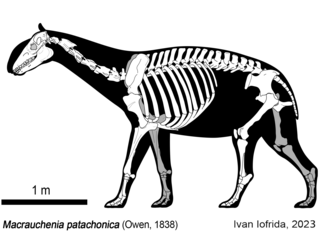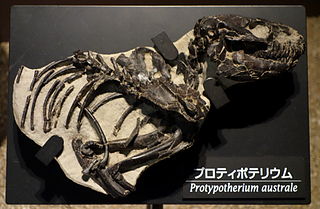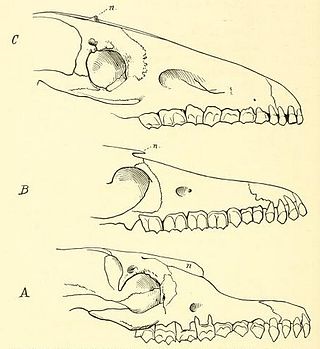
Litopterna is an extinct order of South American native ungulates that lived from the Paleocene to the end of the Pleistocene-early Holocene around 63 million-12,000 years ago, and were also present in Antarctica during the Eocene. They represent the second most diverse group of South American ungulates after Notoungulata. It is divided into nine families, with Proterotheriidae and Macraucheniidae being the most diverse and last surviving families.

Macraucheniidae is a family in the extinct South American ungulate order Litopterna, that resembled various camelids. The reduced nasal bones of their skulls was originally suggested to have housed a small proboscis, similar to that of the saiga antelope. However, one study suggested that they were openings for large moose-like nostrils. Conversely, prehistoric pictographs by indigenous people seems to depict animals interpreted as macraucheniids with trunks. Their hooves were similar to those of rhinoceroses today, with a simple ankle joint and three digits on each foot. Thus, they may have been capable of rapid directional change when running away from predators, such as large phorusrhacid terror birds, sparassodont metatherians, giant short-faced bears (Arctotherium) and saber-toothed cats (Smilodon). Macraucheniids probably lived in large herds to gain protection against these predators, as well as to facilitate finding mates for reproduction.

Theosodon is an extinct genus of litoptern mammal from the Early to Middle Miocene of South America.

Protypotherium is an extinct genus of notoungulate mammals native to South America during the Oligocene and Miocene epochs. A number of closely related animals date back further, to the Eocene. Fossils of Protypotherium have been found in the Deseadan Fray Bentos Formation of Uruguay, Muyu Huasi and Nazareno Formations of Bolivia, Cura-Mallín and Río Frías Formations of Chile, and Santa Cruz, Salicas, Ituzaingó, Aisol, Cerro Azul, Cerro Bandera, Cerro Boleadoras, Chichinales, Sarmiento and Collón Curá Formations of Argentina.
Huayqueriana is an extinct genus of South American litoptern, related to Macrauchenia, and belonging to the same family, Macraucheniidae. It was formerly known as Macrauchenidia latidens, described in 1939 by Cabrera, but redefined as Huayqueriana in 2016 based on the earlier name convention of Rovereto 1914. The genus is named after the Huayquerías Formation and the eponymous Huayquerian South American land mammal age defined at the formation.

Xenorhinotherium is an extinct genus of macraucheniine macraucheniids, closely related to Macrauchenia of Patagonia. The type species is X. bahiense.

Cramauchenia is an extinct genus of litoptern South American ungulate. Cramauchenia was named by Florentino Ameghino. The name has no literal translation. Instead, it is an anagram of the name of a related genus Macrauchenia. This genus was initially discovered in the Sarmiento Formation in the Chubut Province, in Argentina, and later it was found in the Chichinales Formation in the Río Negro Province and the Cerro Bandera Formation in Neuquén, also in Argentina, in sediments assigned to the SALMA Colhuehuapian, as well as the Agua de la Piedra Formation in Mendoza, in sediments dated to the Deseadan. In 1981 Soria made C. insolita a junior synonym of C. normalis. A specimen of C. normalis was described in 2010 from Cabeza Blanca in the Sarmiento Formation, in sediments assigned to the Deseadan SALMA.

Scalabrinitherium is an extinct genus of mammals of the family Macraucheniidae. Fossils of this animal were found among the fossils of prehistoric xenarthrans in the Ituzaingó Formation of Argentina.

Proterotheriidae is an extinct family of litoptern ungulates known from the Oligocene-Late Pleistocene of South America. Members of the group were small-medium sized cursorial herbivores with brachydont teeth, with their toes showing progressive reduction, with later members of the group bearing weight on a single large toe similar to living horses.
The Agua de la Piedra Formation is a Late Oligocene geologic formation of the Malargüe Group that crops out in the southernmost Precordillera and northernmost Neuquén Basin in southern Mendoza Province, Argentina.
Cullinia is an extinct genus of litoptern, an order of South American native ungulates that included horse-like and camel-like animals such as Macrauchenia. It is only known from fragmentary remains. Cullinia levis is known from Chasicoan remains found in the Arroyo Chasicó Formation of Argentina, and remains from the Brazilian state of Acre and the Huayquerian Ituzaingó Formation have been assigned to Cullinia sp..

Cramaucheniinae is a paraphyletic subfamily of macraucheniids that originated in the middle Eocene. The size range of the group ranged from small, basal forms to larger and more derived forms. During their evolution, the cramaucheniines undergone a trend from evolving from small basal forms such as Polymorphis into larger, more derived taxa such as Theosodon.
Promacrauchenia is an extinct genus of macraucheniids that lived during the Late Miocene to Late Pliocene epochs of what is now Argentina and Bolivia. It belongs to the subfamily Macraucheniinae, which also includes Huayqueriana, Macrauchenia, and Xenorhinotherium. Fossils of this genus have been found in the Ituzaingó, Andalhuala, and Cerro Azul Formations of Argentina.
Windhausenia is an extinct genus of mammals belonging to the family Macraucheniidae and the order Litopterna. While it reached the size of its better known relative Macrauchenia, its constitution was lighter. Remains from the genus have been uncovered in Argentina.
Polymorphis is an extinct genus of litopterns belonging to the family Macraucheniidae. It lived during the Middle Eocene of Argentina.

Paramacrauchenia is an extinct genus of proterotheriid litopterns from the Early Miocene of what is now Argentina and Chile. Its fossils have been found in the Sarmiento and Santa Cruz Formations of Argentina and Chile.
Macraucheniopsis is an extinct genus of litoptern mammal belonging to the family Macraucheniidae from the Middle to Late Pleistocene of Argentina. It, along with Macrauchenia, Neolicaphrium, and Xenorhinotherium were among the youngest known genera of litopterns.
Caiman australis is an extinct species of caiman described in 1858 on the basis of a left maxilla that was collected from the Upper Miocene age Ituzaingó Formation of Entre Rios, Argentina.
Chasicobradys is an extinct genus of ground sloths of the family Nothrotheriidae that lived in what is now Argentina. Chasicobradys was discovered in the Arroyo Chasicó Formation, in Buenos Aires Province. It is only known from jaw fragments and teeth, which allowed the identification of this species, and was classified as a member of the nothrotheriid subfamily Nothrotheriinae, which comprises small to medium-sized species of ground sloths.
Pternoconius is an extinct genus of macraucheniid litoptern from the Late Oligocene and Early Miocene of Argentina. Fossils of this genus have been found in the Sarmiento Formation of Argentina.
















